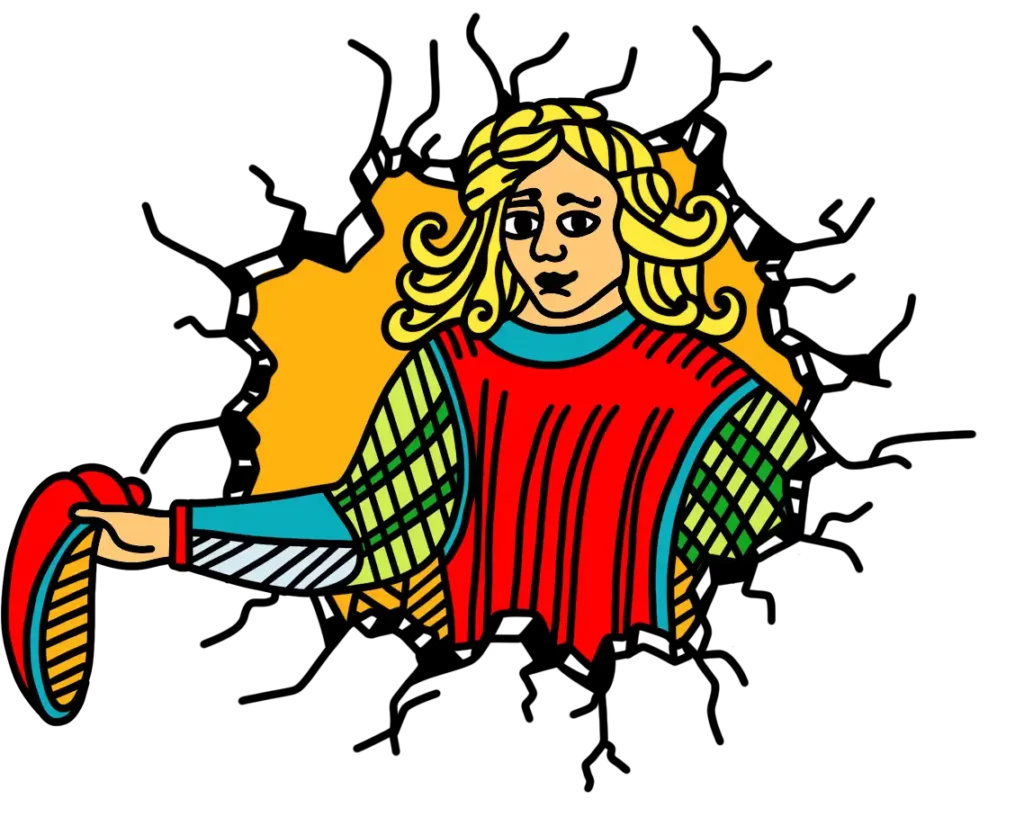
“To cling to the known is to remain a prisoner of ignorance.”
The name of this card is called “le prisonnier” in French. It can be translated as “the prisoner” in English. If you notice any translation errors in this article, please let us know for our entire community. You can leave your comment at the bottom of this page.

How did the prisoner end up in this prison? By will, by force, by stupidity? What was his journey? Will he come out of this dark and obscure cave? And why leave it, if we are happy there? Is it a comfortable shelter from the outside world? Is comfort a good enough reason? Is the prisoner aware of his position?All these questions bring us to the myth of Plato’s cave. The prisoner has 2 choices. Either the prisoner improves his incarceration, but he will always be in the materiality of his prison, or he leaves the prison and detaches himself from the matter he ink,to find the light from the outside. A difficult, unknown journey, far from easy. As a general rule, those who become aware of their confinement fall into the trap of their conscience. In fact, he knows that he is locked up and uses an excuse, a pretext, an escape to find a cause for his confinement. The only way out is to find the flaw, the breach, the opportunity to leave this hell. Besides, the word “hell” and the word “enclose” consist of the same radical. It is therefore radical to get out of this situation. Conversely, those who are not aware of their confinement, driven by the futile things that are offered to them, that they are kept in their ignorance for reasons of dominance of the mind, are quite simply blocked. The only way is awareness, even if it is late. This requires listening, awareness, maturity. Only fools don’t change their minds, it’s never too late to grow up and run away.
The road out will probably not be easy. Leaving prison requires preparation, programming and adaptation to the outside world. The path will not be easy and undoubtedly very laborious. Some prisoners throw in the towel and prefer to improve their incarceration. Let us never forget that a prison is a prison. Whether it’s golden or not. Just as leaving prison does not mean ending up in another. Hope, strength, self-sacrifice and courage will be necessary for us. The prison can be gilded, everything is gold and luxurious ornaments, but the mind is not in its place, it is partitioned in a narrow courtyard, without real freedom, or on parole. The prison can be iron, dark and gloomy, it is reductive to precarious conditions. The prison can be “doing”, a continuous sequence of tasks that do not allow the mind to flourish. The prison of “doing” is the obstacle to being. And if quite simply, we had to stop doing something to get out of it, an invitation to be. Indeed, to be is above all to exist, in the sense that the inner self corresponds to the outer self. Only when we do, we are not. We do what I am told to do, what is expected of me, what is desired of me. But is it me?The verb “to be” is different from the verb “to do”. Just like the verb “to have” is too. Having a nice cell does not make me a golden person. The prisoner may also be in a dogmatic vision of society, where his freedom of thought and his free will are crushed. Let’s not take life imprisonment! Let’s free ourselves from these prisons.
The prisoner is a psychologically complex figure. He represents a person who is physically imprisoned, but who can also be mentally and emotionally imprisoned. Confinement in a cell can lead to feelings of isolation, despair and frustration. The prisoner is faced with the loss of his freedom and the uncertainty of his future. strong> He may also experience shame, guilt or regret for his actions which led him to prison. Emotionally, the prisoner may also suffer from mental health problems such as anxiety, depression or post-traumatic stress disorder. Conditions of other detentions, conflicts with inmates or guards, and memories of traumatic events can all contribute to this psychological suffering. However, the prisoner can also demonstrate resilience and inner strength. He can use this period of confinement to reflect on himself and his life choices. He can thus develop adaptation and survival skills in difficult situations. Additionally, the prisoner can be seen as a symbol of redemption. Through rehabilitation programs, the prisoner can work to repair the wrongs suffered and reintegrate into society. By Ultimately, the prisoner is a figure who embodies both suffering and resilience and reminds us that being free is beautiful.
Suffering
Resilience
Reflection
Patience
Pay his debt
Will
Find the fault
Be satisfied in his misfortune
Confinement
Confinement
Willpower
Golden prison
Prison to “do”
Precariousness
Parole


